Setting Bandsaw Blade Tension
Learn to set your bandsaw’s tension to ensure cuts that are straight and evenFinding the correct blade tension always seems to be something of a mystery among woodworkers. There are all kinds of methods out there, such as plucking the blade like a guitar string until it produces a clear tone of a specific musical pitch. Although I have no doubt that this method works for a few musically inclined woodworkers, I question its practicality and accuracy for the rest of us. Other theories are even more abstract, such as the notion that you should find the tension that makes your bandsaw “comfortable.” To me, this statement seems too vague.
In an effort to avoid adding to the confusion, I’m going to give you some practical ideas on tensioning blades so that you can adjust your saw for accurate cuts. But first I’d like to make some points about bandsaw blades and tension.
Finding the right tension
Bandsaw blades require tension and lots of it to consistently produce straight, uniform cuts, especially in thick or dense stock. Most blade manufacturers recommend 15,000 psi to 20,000 psi for a common carbon-steel blade.
However, bimetal, spring-steel, and carbide-tipped blades are much stronger than carbon-steel blades, so manufacturers recommend a much higher tension: 25,000 psi to 30,000 psi. Why do bandsaw blades need so much tension? For beam strength. The tighter the blade is stretched, the more rigid it becomes and the less tendency it will have to deflect in the cut.
You only need maximum tension for the most demanding cuts, such as sawing dense hardwoods or stock of the maximum thickness that will fit under a saw’s guides. In simpler circumstances, you can back off the tension a little.
All blades, regardless of width, require the same amount of tension for maximum beam strength. The variable factor is the amount of pulling force needed. For example, it takes approximately 200 lb. of force pulling on a 1/4-in.-wide by 0.025-in.-thick blade to create 25,000 psi of tension. Conversely, a 3/4-in.-wide by 0.032-in.-thick blade will require approximately 800 lb. of force to create the same 25,000 psi of tension.
Measuring tension
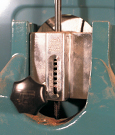 The tension scales on most bandsaws are inaccurate. It’s common for scales to indicate a tension far above the actual tension on the blade.
The tension scales on most bandsaws are inaccurate. It’s common for scales to indicate a tension far above the actual tension on the blade.
Bandsaw-blade tension scales are notoriously inaccurate. Tests conducted by consumer woodworking magazines have shown this, and my own tests using six different bandsaws confirmed their results. For my tests, I used a blade tension meter that clamps to the blade and gives an accurate reading on a dial indicator. The readings of all the saw tension scales that I tested, including those on the expensive floor-model saws, were lower than that indicated on the meter. Although the scales on the large machines were close to being accurate, the scales on the 14-in. saws were way off. To make matters worse, the springs used in the tension scales on bandsaws weaken with age, further reducing their accuracy.
So how do you know when blade tension is correct? The most accurate way is to check it with a tension meter such as the one I used in my tests. But tension meters are expensive — typically around $300. I know what you’re thinking — is there another way? Yes, but none is as accurate as a tension meter. Other tensioning methods will work, but they’re a lot like gauging air pressure in a bicycle tire simply by squeezing it.
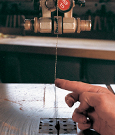 If you don’t have a tension meter, you can roughly tension the blade by eye. Raise the guides about 6 in. off the table and push the blade. The blade should deflect no more than 1/4 in.
If you don’t have a tension meter, you can roughly tension the blade by eye. Raise the guides about 6 in. off the table and push the blade. The blade should deflect no more than 1/4 in.
A good place to begin is to tension the blade until the meter reads proper tension for the next wider blade. For example, if you’re tensioning a 3/8-in. blade, I would set the scale to 1/2 in. This works most of the time, since most sawing operations don’t require maximum tension.
Another method is to test the tension by the amount that the blade will deflect sideways. First, I set the upper guides about 6 in. off the table. Then using a moderate amount of pressure from my index finger (obviously with the saw turned off!), I push the blade sideways. I don’t want the blade to bow more than 1/4 in. Of course, you’ll have to develop a feel for how much pressure is moderate.
Although both of these methods work, they are imprecise. But as I stated earlier, in most situations maximum blade tension isn’t necessary. I always test the blade tension with a trial piece before making cuts in an actual workpiece. If the blade wanders in the cut (assuming other factors such as blade sharpness and guide setting are correct), I’ll gradually increase the blade tension.
Blade tensioning for resawing
Resawing thick, hard stock places the most demands on the blade. If the blade tension is inadequate, the blade will bow and the stock may be spoiled.
I remember a situation some years ago when I attempted to resaw a wide board. It was a plank of deep red cherry — highly figured with truly awesome curly grain. I wanted to make book-matched panels for a door in a cupboard. Since I was in a hurry, I neglected the necessary precautions such as selecting a blade with the right pitch and tensioning it properly. The blade bowed badly during cutting, making one of the planks terribly thin at the end. The stock was thicker than necessary, so I was lucky enough just to squeeze out the thickness I needed from the resawn plank. But I learned my lesson: A blade needs beam strength for resawing.
Beam strength, the blade’s ability to resist deflection, is achieved by combining several factors, including correct blade pitch, blade width, and precise guide settings. But a key factor in achieving beam strength is applying the maximum blade tension that the blade manufacturer recommends.
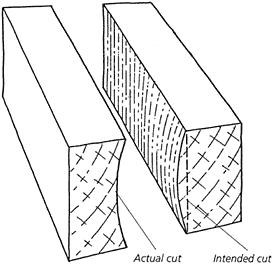
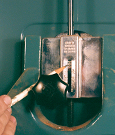 On a small consumer-grade bandsaw, I tension a 1/2-in. blade for resawing by almost completely compressing the tension spring.
On a small consumer-grade bandsaw, I tension a 1/2-in. blade for resawing by almost completely compressing the tension spring.
Some woodworkers may question whether maximum blade tension will in any way damage the saw. Based on years of experience with my 14-in. Delta bandsaw, the answer is no. But I should make it clear that I recommend using maximum blade tension only for occasional, brief periods of resawing. Otherwise, I keep the tension low for everyday sawing. I release the tension when I know I won’t be using the saw for a while.
If you’ve purchased a bandsaw with a wheel diameter of 18 in. or more, then you’re most likely planning to do serious resawing from time to time. In that case, I suggest that you also spend the money on a tension meter. Large bandsaws have frames that are capable of overtensioning a blade, which causes it to break. A tension meter is the most accurate way of setting the blade tension.
If you own one of the many consumer bandsaws with a wheel diameter of 14 in. or less, then I would use a blade no wider than 1/2 in. for resawing and tension it until the tension spring is nearly compressed.
 |
From The Bandsaw Book, pp.92-97 (also now available in ebook format) |
Get more about Bandsaws from FineWoodworking.com
- John White makes a jig to help set the tension on a bandsaw blade
- Tension bandsaws without a gauge
- Shopmade Tension Gauge
- 5 Essential Bandsaw Jigs from Michael Fortune




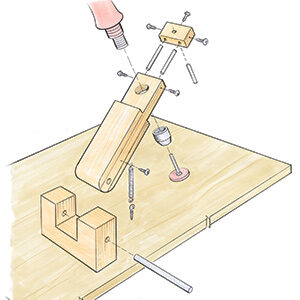
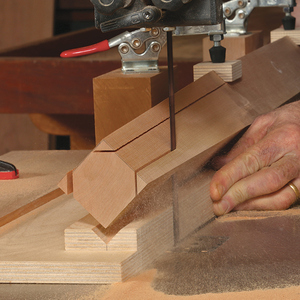
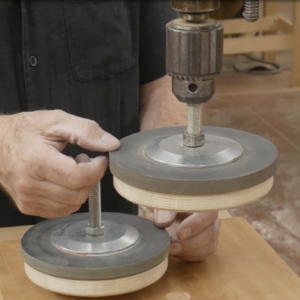











Comments
This article might be updated based on information I came across here:
http://www.modelenginemaker.com/index.php?topic=1972.0
It shows a tension meter constructed with a digital caliper clamped to the saw blade to measure how much the blade elongates when tension is applied, and an associated spreadsheet to obtain PSI of tension in the blade.
Log in or create an account to post a comment.
Sign up Log in